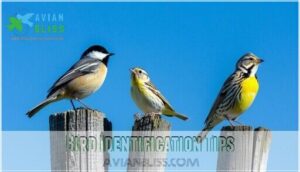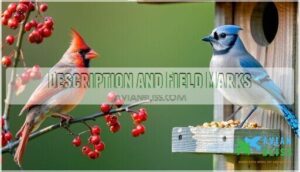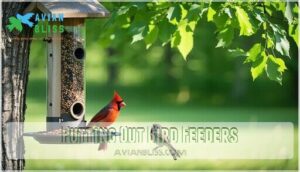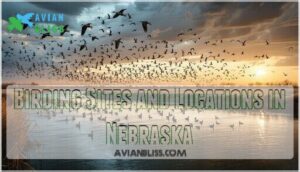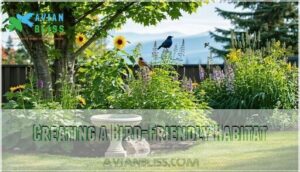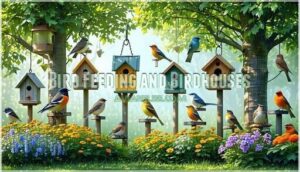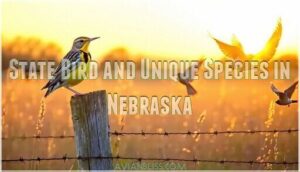This site is supported by our readers. We may earn a commission, at no cost to you, if you purchase through links.
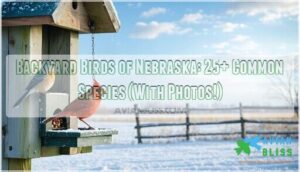
American Robins hop across your lawn hunting worms, while Northern Cardinals add bright red splashes to winter feeders.
Blue Jays patrol your yard like feathered sentinels, and Black-capped Chickadees perform acrobatic tricks at seed feeders.
House Finches chatter in small flocks, Eastern Bluebirds perch on fence posts, and Baltimore Orioles visit during migration.
Nebraska’s prairies and woodlands create perfect habitat for both year-round residents and seasonal visitors.
The secret to attracting more species lies in understanding their specific feeding and nesting preferences.
Table Of Contents
- Key Takeaways
- Common Backyard Birds in Nebraska
- Identifying Backyard Birds in Nebraska
- Attracting Birds to Your Backyard
- Birding Sites and Locations in Nebraska
- Birds in Nebraska by Season
- Creating a Bird-Friendly Habitat
- Bird Feeding and Birdhouses
- Protecting Backyard Birds in Nebraska
- State Bird and Unique Species in Nebraska
- Frequently Asked Questions (FAQs)
- How do I identify a bird in my yard?
- What is the most common bird in Nebraska?
- How do I find out what birds are in my area?
- What are the big GREY birds in Nebraska?
- What are the big gray birds in Nebraska?
- What birds can I attract to my yard?
- How do seasonal changes affect bird migration?
- What are common predators of backyard birds?
- How do weather patterns impact bird behavior?
- What local plants attract Nebraska birds?
- Conclusion
Key Takeaways
- You’ll attract over 25 backyard bird species in Nebraska by providing three essentials: quality feeders with sunflower seeds, fresh water sources, and native plants like elderberry and purple coneflower that offer natural food and shelter.
- You can identify Nebraska’s common birds by observing key field marks like the Northern Cardinal’s bright red plumage and black face mask, the American Robin’s rusty-red breast, and listening for their distinctive songs and calls.
- You’ll see different birds throughout the seasons—year-round residents like Blue Jays and Cardinals stay put, while seasonal visitors like Cedar Waxwings and Baltimore Orioles migrate through during spring and fall.
- You’ll protect your backyard birds by avoiding pesticides, installing window decals to prevent collisions, keeping cats indoors, and maintaining clean feeders to prevent disease spread among visiting species.
Common Backyard Birds in Nebraska
You’ll find over 25 common bird species visiting Nebraska backyards throughout the year, from bright red Northern Cardinals to cheerful Black-capped Chickadees.
Nebraska’s backyard birds bring year-round color and song to your outdoor space, from cardinals to chickadees.
These familiar birds include year-round residents like American Robins and Blue Jays, plus seasonal visitors that migrate through the state during spring and fall, and are among the common bird species.
Year-Round Birds
Throughout the year, Nebraska’s backyard birds showcase remarkable Resident Bird Adaptations and Winter Survival Strategies. These yearround residents like the American Robin and Darkeyed Junco thrive in diverse Year-Round Bird Habitats despite harsh winters.
The American Goldfinch, for example, exhibits seasonal plumage variations as it changes from bright yellow in summer to olive in winter.
Your backyard becomes a conservation hub:
- American Goldfinch – bright yellow summer, olive winter plumage
- Northern Cardinal – brilliant red males year-round
- Blue Jay – intelligent, social forest dwellers
Nebraska Bird Conservation starts in your yard!
Seasonal Birds in Nebraska
Seasonal birds transform Nebraska backyards throughout the year, creating exciting opportunities for birdwatchers to witness nature’s rhythms.
Migration Patterns bring Cedar Waxwings in March and April, while Summer Visitors like Common Grackles establish Breeding Seasons in woodland edges.
Winter Adaptations help many species survive Nebraska’s harsh months, though some become uncommon visitors. To help birds survive the winter, consider creating winter bird habitat in your backyard.
Track these Seasonal Habitats changes:
- Spring warblers arriving earlier each year
- Cedar Waxwings peaking during October migrations
- Rare winter irruptions bringing unexpected species
- Common Grackles concentrating in southern regions
- Year-round Cardinals providing consistent backyard color
Most Common Birds in Nebraska
Nebraska’s backyard birds show fascinating Population Trends and Regional Variations across the state.
Bird identification becomes easier when you know which common birds visit most frequently.
| Species | Habitat Preferences | Nesting Habits |
|---|---|---|
| American Robin | Open woodlands, parks | Tree cavities, 10-25 feet |
| Red-winged Blackbird | Marshes, wetlands | Cattail stems, low shrubs |
| Blue Jay | Dense forests, suburbs | Fork of tree branches |
| Northern Cardinal | Woodland edges, gardens | Dense shrubs, 3-10 feet |
These Nebraska birds offer distinct Bird Songs that help identify each species in your yard.
Identifying Backyard Birds in Nebraska
You’ll need to observe key features like size, color patterns, and behavior to correctly identify Nebraska’s backyard birds.
Look for distinct field marks such as the Northern Cardinal’s bright red plumage and black face mask, or the Red-winged Blackbird’s red and yellow shoulder patches that help separate similar species, including the Northern Cardinal.
Bird Identification Tips
Identifying backyard birds in Nebraska becomes easier when you know what to look for. Start by observing field marks – distinctive features like wing bars, eye rings, and tail patterns that separate similar species.
Notice plumage variations between males and females, as many Nebraska birds show dramatic differences. Male Northern Cardinals sport bright red feathers while females wear subtle brown tones with red highlights.
Listen carefully to bird songs and calls. Each species has unique vocalizations that often reveal their identity before you spot them. The American Robin’s cheerful melody differs greatly from the Blue Jay’s harsh calls.
Pay attention to seasonal changes in appearance. American Goldfinches transform from bright yellow summer plumage to dull olive-brown winter colors. Size comparisons help too – compare unknown birds to familiar species like sparrows or robins. These bird identification techniques will enhance your bird watching experience with common birds throughout Nebraska’s seasons.
Description and Field Marks
Once you’ve mastered basic identification tips, field marks become your roadmap to recognizing Nebraska birds.
These distinctive features separate similar species and reveal each bird’s unique identity.
Focus on these key characteristics for accurate backyard birds identification:
- Plumage variations: Notice the male cardinal’s bright red versus the female’s subtle brown with red highlights
- Size comparison: Compare a tiny chickadee to a robin-sized blue jay
- Vocalizations: Listen for each species’ distinctive calls and songs
Regional differences and juvenile markings add complexity to your common birds guide.
Attracting Birds to Your Backyard
You can turn your backyard into a bird haven by providing three essential elements: food through well-stocked feeders, fresh water sources, and suitable nesting spots with native plants.
These simple additions will attract Nebraska’s common species like American Robins, Blue Jays, and Northern Cardinals to visit your yard regularly throughout the year, making it a welcoming spot for native plants.
Putting Out Bird Feeders
Bird feeders transform your yard into a bustling hub for Nebraska’s backyard birds.
Start with tube feeders for sunflower seeds—they’re squirrel-resistant and attract cardinals, chickadees, and nuthatches.
Platform feeders work well for ground-feeding birds like juncos.
Choose quality bird seeds over cheap mixes; black oil sunflower seeds are gold standard.
Place feeders near trees for cover but away from windows.
Clean feeders monthly with diluted bleach to prevent disease.
Winter feeding becomes especially important when natural food sources dwindle.
You can find various feeder options online.
Adding a Water Source
Beyond feeders, water becomes your backyard’s biggest bird magnet. Nebraska’s backyard birds need fresh water year-round for drinking and bathing. Position water sources near shelter but visible for bird watching.
Clean bird baths weekly to prevent mosquitoes and maintain bird conservation efforts. To further enhance your yard, consider how native trees offer shelter.
Essential water source types for attracting birds:
- Shallow bird baths with textured bottoms for secure footing
- Heated winter water sources to prevent freezing during Nebraska’s cold months
- Dripping fountains creating sound that draws birds from distances
- Ground-level water dishes for ground-feeding species like juncos
- Multiple water stations placed at varying heights throughout your yard
Offering Birdhouses and Native Plants
Once you’ve added water, birdhouses and native plants complete your backyard transformation.
Smart birdhouse placement attracts cavity-nesting birds—mount boxes 5-6 feet high, facing southeast.
Native plants for birds like elderberry and sumac provide nesting materials and seeds.
This plant selection creates habitat diversity, offering shelter benefits that turn your Nebraska yard into prime bird habitat for backyard birds.
Birding Sites and Locations in Nebraska
You’ve created a bird-friendly backyard, but Nebraska’s vast landscapes offer incredible birdwatching opportunities beyond your yard.
The state’s diverse ecosystems host amazing species throughout the year.
Nebraska’s premier birding locations provide unforgettable experiences:
- Platte River – Famous for Sandhill Crane migrations and waterfowl gatherings
- Rainwater Basin – Critical stopover for migrating ducks and geese
- Niobrara Valley – Home to eastern and western bird species overlap
- Panhandle Lakes – Attract pelicans, cormorants, and shorebirds year-round
Birds in Nebraska by Season
You’ll notice different bird species throughout Nebraska’s changing seasons, with some staying year-round while others migrate through or visit during specific months.
Understanding seasonal patterns helps you predict which birds you’ll spot in your backyard during summer’s busy breeding season, winter’s quiet months, and the exciting spring and fall migrations.
Summer Birds in Nebraska
Nebraska’s Summer Birding season transforms your backyard into nature’s nursery. During Nesting Season, you’ll witness fascinating Breeding Behaviors as local birds raise Juvenile Birds.
These backyard birds showcase vibrant plumage while hunting for Insect Diets. One might even spot red-bellied woodpeckers visiting feeders.
Watch for these summer stars:
- American Robin gathering earthworms for hungry chicks
- Baltimore Orioles weaving hanging basket nests
- Northern Cardinals teaching fledglings to forage
- American Goldfinches timing breeding with thistle blooms to raise their young, making the most of the Summer Birding season.
Winter Birds in Nebraska
Resilience defines Nebraska’s winter backyard birds as temperatures plummet below freezing.
Approximately 125 species brave the cold, with Dark-eyed Juncos, Northern Cardinals, and Black-capped Chickadees leading the hardy bunch.
These survivors showcase remarkable Winter Survival strategies and Snow Adaptations that’ll amaze you.
Their Cold Weather Diet shifts to high-energy foods like sunflower seeds and suet—perfect for your bird feeders.
Watch for American Tree Sparrows flocking together, demonstrating clever Roosting Behavior to conserve warmth.
Unlike fair-weather friends, these tough Nebraska residents stick around when others follow southern Migration Patterns.
Stock your feeders with nutrient-rich options to support their incredible winter endurance.
Spring and Fall Migrations
Spring and fall transform your backyard into migration central along Nebraska flyways.
Over 300 bird species use stopover habitats here, with Sandhill Cranes creating spectacular gatherings.
Migration triggers like temperature shifts bring waves of warblers, thrushes, and waterfowl through your yard.
Despite migration challenges and species decline, you’ll witness nature’s greatest show with proper timing and patience.
Creating a Bird-Friendly Habitat
You can transform your backyard into a bird haven by planting native Nebraska species like elderberry and sunflowers, which provide natural food sources year-round.
Creating layers of vegetation from ground cover to tall trees, along with reliable water sources, gives birds the shelter and resources they need to thrive in your space, utilizing native species.
Growing Native Plants
You’ve watched birds through the seasons—now let’s build them a home they’ll truly love.
Growing native plants transforms your yard into a Nebraska bird paradise that feeds and shelters local species year-round.
- Purple Prairie Clover attracts seed-eating goldfinches with late-summer blooms
- Wild Bergamot draws insects that woodpeckers and nuthatches devour
- Little Bluestem provides nesting materials and winter seed heads
- Black-eyed Susan offers abundant seeds for cardinals and chickadees
Providing Food and Water Sources
Beyond just hanging feeders, successful bird feeding requires understanding what backyard birds actually need.
Different feeder types attract specific Nebraska backyard birds – tube feeders work well for goldfinches, while platform feeders welcome cardinals.
Fresh birdseed prevents mold and illness, so replace it weekly.
Consider browsing Nebraska bird feeder options for your yard.
Water features like shallow birdbaths encourage visits, especially during winter when natural sources freeze.
Seasonal feeding adjustments help maintain year-round bird activity while ensuring food safety.
Creating a Diverse Habitat
Once you’ve established bird feeders and water sources, focus on creating diverse layers that’ll transform your yard into a Nebraska backyard birds paradise.
Effective habitat management requires three essential components:
- Native plantings – Choose tall trees, shrubs, and perennials that provide natural birdseed and shelter
- Water features – Install bubbling fountains alongside basic bird baths
- Shelter options – Build brush piles using logs and branches for safe nesting spaces.
Consider sourcing native plants from local nurseries to further enhance the habitat.
Bird Feeding and Birdhouses
You’ll need the right feeders and nest boxes to successfully attract Nebraska’s backyard birds to your property.
Squirrel-proof feeders protect your bird seed investment, while properly placed birdhouses provide safe nesting spots for species like chickadees, nuthatches, and woodpeckers.
Using Squirrel-Proof Feeders
Your bird feeders face constant raids from crafty squirrels in Nebraska backyards.
Weight-activated feeders shut when squirrels climb on, protecting your birdseed investment.
Placement matters – position feeders five feet from jumping points.
DIY solutions include adding baffles or cages.
Squirrel behavior shows they’ll find ways around obstacles, so feeder types with motorized mechanisms work best for serious bird feeding enthusiasts.
Effective solutions include using specialized feeder products.
Setting Up Birdhouses and Nest Boxes
Now that your feeders are squirrel-proof, you’ll want to give Nebraska’s backyard birds cozy nesting spots.
Smart birdhouse construction starts with proper box dimensions and material selection.
- Cedar construction: Weather-resistant wood that’ll last seasons
- Strategic placement: Mount 5-15 feet high, facing away from prevailing winds
- Regular monitoring: Check nests weekly during breeding season
Clean boxes after each brood for healthy bird nests.
Protecting Backyard Birds in Nebraska
You can protect the birds visiting your Nebraska backyard by making simple changes that reduce common dangers.
Avoiding pesticides, placing decals on windows, and keeping cats indoors will help create a safer environment for Cardinals, Blue Jays, and other local species.
You can make these changes to help the birds.
Avoiding Pesticides and Harmful Chemicals
Chemical exposure threatens Nebraska’s backyard birds more than most homeowners realize.
Create backyard bird sanctuaries that protect Nebraska’s feathered visitors from hidden dangers lurking in everyday garden products.
Your feathered visitors face serious risks from common lawn and garden products that seem harmless but pack a deadly punch.
| Chemical Type | Impact on Birds | Safe Alternative |
|---|---|---|
| Neonicotinoid pesticides | Neurological damage, navigation problems | Beneficial insects, companion planting |
| Herbicides | Water contamination, reproductive issues | Hand weeding, organic mulches |
| Slug baits | Bird poisoning through direct consumption | Coffee grounds, copper barriers |
Smart pesticide alternatives protect bird habitats while maintaining your garden’s health and beauty.
Providing a Safe Environment
Beyond avoiding chemicals, your Nebraska backyard needs thorough predator control and nesting safety measures.
Creating secure bird habitats protects species from disease prevention concerns while supporting habitat preservation efforts.
Consider these safety strategies:
- Install predator guards on bird feeders and bird houses to deter cats and raccoons
- Maintain clean feeding stations to prevent disease spread among backyard birds
- Remove chemical hazards like antifreeze and rat poison from accessible areas
Reducing Window Collisions
After creating a safe environment, preventing window collisions protects Nebraska’s birds from deadly impacts.
Install window film or external screens to break up reflections that confuse birds.
Bird-safe glass and strategic decal placement help feathered friends recognize barriers.
Habitat modification around windows reduces dangerous fly zones.
These simple bird conservation efforts make your birdwatching sanctuary truly safe for visiting species.
State Bird and Unique Species in Nebraska
You’ll recognize Nebraska’s state bird, the Western Meadowlark, by its bright yellow chest and sweet, flute-like song that carries across open grasslands.
Beyond this iconic species, you can spot several unique birds in your backyard that aren’t found everywhere, including rare visitors and species that make Nebraska special for birdwatchers, with the Western Meadowlark being a key example of what makes Nebraska special for birdwatchers.
Rare and Endangered Birds in Nebraska
While protecting your backyard birds matters, Nebraska’s rarest species face even greater challenges. Several bird species in Nebraska teeter on the brink of extinction due to habitat loss and other mounting pressures.
The Interior Least Tern has fewer than 100 breeding pairs statewide, while Piping Plover populations have plummeted over 80% in Nebraska’s river systems. These population declines stem from agricultural expansion eliminating 90% of native grasslands and wetland drainage reducing breeding grounds by 75%.
Nebraska bird conservation efforts include targeted recovery programs through the Nebraska Game and Parks Commission. Conservation status efforts are essential to their survival. Here’s what threatens these species’ survival:
- Climate change disrupts migration patterns and breeding cycles
- Power lines and wind turbines create deadly collision risks
- Invasive species compete for limited food and nesting resources
Conservation efforts continue monitoring these vulnerable Nebraska bird species.
Birds to Spot in Nebraska
Looking to expand your Nebraska birdwatching adventures?
You’ll discover the western meadowlark‘s melodic song echoing across prairies as our state bird.
Watch for white-breasted nuthatches spiraling down tree trunks and gray catbirds mimicking other species.
American Robins and Northern Cardinals frequent backyards year-round. Set up feeders to attract these common bird species and enhance your birdwatching experience.
Frequently Asked Questions (FAQs)
How do I identify a bird in my yard?
Observe the bird’s size, colors, and markings first.
Note its beak shape and behavior. Check field guides or apps like Merlin Bird ID.
Listen to its song. These details help you identify common backyard species accurately.
What is the most common bird in Nebraska?
The American Robin stands out as Nebraska’s most common bird, with its distinctive rusty-red breast and gray back.
You’ll spot these year-round residents hopping across lawns, parks, and woodlands throughout the state.
How do I find out what birds are in my area?
Download the eBird app or visit ebird.org to discover birds in your neighborhood.
Check local Audubon chapters for bird walks and field guides.
Your state’s wildlife agency website also provides regional bird lists and seasonal migration information.
What are the big GREY birds in Nebraska?
The big gray birds you’re spotting in Nebraska are likely Mourning Doves.
They’re about 12 inches long, with soft gray-brown feathers, black wing spots, and a distinct cooing call that’s hard to miss.
What are the big gray birds in Nebraska?
You’ll likely spot Mourning Doves and Common Grackles as Nebraska’s most prominent gray birds.
Mourning Doves show soft brown-gray plumage, while Common Grackles display glossy blackish-gray feathers with bronze or green highlights on their heads.
What birds can I attract to my yard?
You can attract birds like Blue Jays, Northern Cardinals, and American Goldfinches by offering sunflower seeds, suet, and Nyjer seed.
Add a birdbath, native plants, and nesting boxes to make your yard inviting.
How do seasonal changes affect bird migration?
When Mother Nature changes her tune, birds respond accordingly.
Seasonal shifts in temperature, daylight, and food availability trigger migration patterns.
You’ll notice birds departing before harsh winters and returning when spring warmth promises abundant insects and nesting opportunities.
What are common predators of backyard birds?
You’ll encounter cats, hawks, owls, snakes, and raccoons threatening your feathered visitors.
Domestic cats pose the biggest danger, killing billions of birds annually.
Keep feeders near cover but away from hiding spots predators use.
How do weather patterns impact bird behavior?
Weather isn’t just background noise for birds—it’s their daily survival guide.
You’ll notice birds change feeding patterns before storms, migrate with temperature shifts, and adjust nesting behaviors based on seasonal weather patterns affecting food availability, which is closely linked to their seasonal habits.
What local plants attract Nebraska birds?
You’ll find sunflowers, purple coneflowers, and black-eyed Susans work wonders for goldfinches and cardinals.
Native elderberries and serviceberries provide natural food sources, while oak trees support insects that attract woodpeckers and nuthatches year-round.
Conclusion
Like a living tapestry woven across Nebraska’s landscape, backyard birds of Nebraska transform ordinary yards into vibrant wildlife sanctuaries.
You’ve learned to identify common species, create bird-friendly habitats, and provide essential resources.
Remember that consistency matters most when feeding birds. Keep feeders clean, water sources fresh, and native plants thriving.
Each small effort contributes to Nebraska’s bird conservation. Your backyard can become a haven where cardinals, chickadees, and countless other species find food, shelter, and safety year-round, making it a true wildlife sanctuary.

